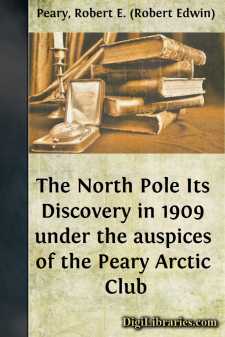Categories
- Antiques & Collectibles 13
- Architecture 36
- Art 48
- Bibles 22
- Biography & Autobiography 813
- Body, Mind & Spirit 138
- Business & Economics 28
- Children's Books 12
- Children's Fiction 9
- Computers 4
- Cooking 94
- Crafts & Hobbies 4
- Drama 346
- Education 46
- Family & Relationships 57
- Fiction 11821
- Games 19
- Gardening 17
- Health & Fitness 34
- History 1377
- House & Home 1
- Humor 147
- Juvenile Fiction 1873
- Juvenile Nonfiction 202
- Language Arts & Disciplines 88
- Law 16
- Literary Collections 686
- Literary Criticism 179
- Mathematics 13
- Medical 41
- Music 40
- Nature 179
- Non-Classifiable 1768
- Performing Arts 7
- Periodicals 1453
- Philosophy 64
- Photography 2
- Poetry 896
- Political Science 203
- Psychology 42
- Reference 154
- Religion 505
- Science 126
- Self-Help 81
- Social Science 81
- Sports & Recreation 34
- Study Aids 3
- Technology & Engineering 59
- Transportation 23
- Travel 463
- True Crime 29
The North Pole Its Discovery in 1909 under the auspices of the Peary Arctic Club
Categories:
Description:
Excerpt
FOREWORD
The struggle for the North Pole began nearly one hundred years before the landing of the Pilgrim Fathers at Plymouth Rock, being inaugurated (1527) by that king of many distinctions, Henry VIII of England.
In 1588 John Davis rounded Cape Farewell, the southern end of Greenland, and followed the coast for eight hundred miles to Sanderson Hope. He discovered the strait which bears his name, and gained for Great Britain what was then the record for the farthest north, 72° 12´, a point 1128 miles from the geographical North Pole. Scores of hardy navigators, British, French, Dutch, German, Scandinavian, and Russian, followed Davis, all seeking to hew across the Pole the much-coveted short route to China and the Indies. The rivalry was keen and costly in lives, ships, and treasure, but from the time of Henry VIII for three and one-half centuries, or until 1882 (with the exception of 1594-1606, when, through Wm. Barents, the Dutch held the record), Great Britain's flag was always waving nearest the top of the globe.
The same year that Jamestown was founded, Henry Hudson (1607), also seeking the route to the Indies, discovered Jan Mayen, circumnavigated Spitzbergen, and advanced the eye of man to 80° 23´. Most valuable of all, Hudson brought back accounts of great multitudes of whales and walruses, with the result that for the succeeding years these new waters were thronged with fleets of whaling ships from every maritime nation. The Dutch specially profited by Hudson's discovery. During the 17th and 18th centuries they sent no less than 300 ships and 15,000 men each summer to these arctic fisheries and established on Spitzbergen, within the Arctic Circle, one of the most remarkable summer towns the world has ever known, where stores and warehouses and reducing stations and cooperages and many kindred industries flourished during the fishing season. With the approach of winter all buildings were shut up and the population, numbering several thousand, all returned home.
Hudson's record remained unequaled for 165 years, or until 1773, when J. C. Phipps surpassed his farthest north by twenty-five miles. To-day the most interesting fact connected with the Phipps expedition is that Nelson, the hero of Trafalgar and of the Battle of the Nile, then a lad of fifteen, was a member of the party. Thus the boldest and strongest spirits of the most adventurous and hardy profession of those days sought employment in the contest against the frozen wilderness of the north.
The first half of the 19th century witnessed many brave ships and gallant men sent to the arctic regions. While most of these expeditions were not directed against the Pole so much as sent in an endeavor to find a route to the Indies round North America—the Northwest Passage—and around Asia—the Northeast Passage—many of them are intimately interwoven with the conquest of the Pole, and were a necessary part of its ultimate discovery. England hurled expedition after expedition, manned by the best talent and energy of her navy, against the ice which seemingly blocked every channel to her ambitions for an arctic route to the Orient....


